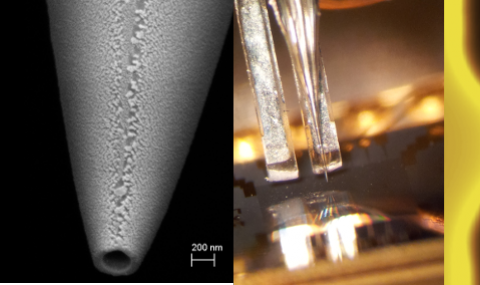We studied the dynamical aspects of the vortex matter phase diagram [1]. The sample edges [2] and extreme anisotropy of BSCCO [3] render naive transport measurements inadequate due to a highly nonuniform current distribution across the width and the thickness of the sample.
Therefore, we devised an alternative indirect approach using array of Hall sensors, which combines measurement of the current distribution across the sample with a simple model of the sample edges and bulk in terms of resistors and inductors [4]. As a result, we unveiled the underlying electrodynamic edge mechanism that drives the previously unresolved Tx transition [5]. We show that below Tx the edge inductance, even though being immeasurably low, governs the dynamics of vortices in the sample.
The edge inductance is then used as a powerful probe for measuring the edge resistance much below the typical transport noise level. At high temperatures the transport current flows uniformly across the sample width. Below the Tsb line the vortex flow across the sample is governed by surface barriers at the sample edges, rather than by bulk vortex properties. At Tx line the frequency-dependent inductive component of the edge impedance becomes equal to the resistive component. The edge resistance across the phase diagram can thus be obtained using a calculated value of edge inductance.

Below the Tsb line edge, rather than bulk, barriers dominate the vortex flow across the sample. Below the Tx line the frequency-dependent inductive component of the edge impedance becomes larger than the resistive one. This enables to probe the edge resistance across the phase diagram.

- The asymmetries of the surface barrier induce a local second-harmonic signal in the ac magnetic field that is self-induced by the transport current. This second harmonic vanishes rapidly at the frequency dependent Tx line at which the edge resistance and reactance become equal.
- By varying frequency, the edge resistance can thus be extracted over a range of parameters. The obtained edge resistance perfectly matches the edge resistance measured by transport at elevated temperatures and extends the data to lower temperatures down to well below the transport noise level.
Additional information
- Transport properties of vortex matter governed by the edge inductance in superconducting Bi2Sr2CaCu2O8 crystals
H. Beidenkopf, Y. Myasoedov, E. Zeldov, E. H. Brandt, G. P. Mikitik, T. Tamegai, T. Sasagawa, and C. J. van der Beek
Phys. Rev. B 80, 224526 (2009). - Transport properties governed by surface barriers in Bi2Sr2CaCu2O8
Dan T. Fuchs , Eli Zeldov , Michael Rappaport , Tsuyoshi Tamegai , Shuuichi Ooi & Hadas Shtrikman
Nature 391, 373 (1998). - New aspects of the mixed state from six-terminal measurements on Bi2Sr2CaCu2Ox single crystals
R. Busch, G. Ries, H. Werthner, G. Kreiselmeyer, and G. Saemann-Ischenko
Phys. Rev. Lett. 69, 522–525 (1992) - Self field of ac current reveals voltage-current law in type-II superconductors
E. H. Brandt, G. P. Mikitik, and E. Zeldov
Phys. Rev. B 74, 094506 (2006) - Possible New Vortex Matter Phases in Bi2Sr2CaCu2O8
D. T. Fuchs , E. Zeldov , T. Tamegai , S. Ooi , M. Rappaport , and H. Shtrikman
Phys. Rev. Lett. 80, 4971 (1998).


